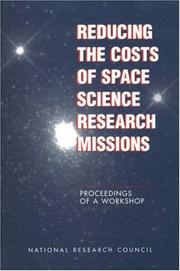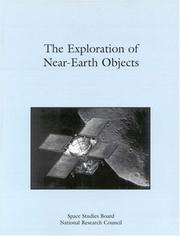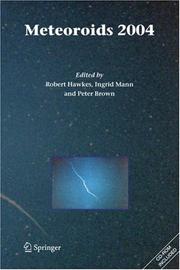| Listing 1 - 5 of 5 |
Sort by
|

ISBN: 0309058295 9786610187140 128018714X 0309569222 0585149445 9780585149448 030908380X 9780309083805 9780309058292 Year: 1997 Publisher: Washington, D.C. National Academy Press
Abstract | Keywords | Export | Availability | Bookmark
 Loading...
Loading...Choose an application
- Reference Manager
- EndNote
- RefWorks (Direct export to RefWorks)
Space shuttles. --- Space debris. --- Meteoroids. --- Risk management. --- Micrometeoroids --- Debris, Space --- Junk in space --- Orbital debris --- Space junk --- Shuttles, Space --- Insurance --- Management --- Space environment --- Space pollution --- Reusable space vehicles

ISBN: 0309060834 0309524075 0585144796 9780585144795 9780309060837 0305060834 0309174082 Year: 1998 Publisher: Washington, D.C. National Academy Press
Abstract | Keywords | Export | Availability | Bookmark
 Loading...
Loading...Choose an application
- Reference Manager
- EndNote
- RefWorks (Direct export to RefWorks)
SCIENCE --- Astronomy --- Comets --- Meteoroids --- Near-earth asteroids --- Astrophysics --- Astronomy & Astrophysics --- Physical Sciences & Mathematics --- Comets. --- Meteoroids. --- Near-earth asteroids. --- Planet-crossing asteroids --- Micrometeoroids --- Asteroids --- Near-Earth objects --- Collisions with Earth
Book
ISBN: 1281250678 9786611250676 0387784195 0387784187 1441926879 Year: 2008 Publisher: [New York?] : Springer,
Abstract | Keywords | Export | Availability | Bookmark
 Loading...
Loading...Choose an application
- Reference Manager
- EndNote
- RefWorks (Direct export to RefWorks)
This volume is a compilation of articles that summarize the most recent results in meteor, meteoroid and related fields presented at the Meteoroids 2007 conference held at the impressive CosmoCaixa Science Museum in Barcelona, Spain. The conference took place between the 11th and the 15th of June and was organized by the Institute of Space Sciences (Consejo Superior de Investigaciones Científicas, CSIC) and the Institut d'Estudis Espacials de Catalunya (IEEC). Researchers in meteor science and supporting fields representing more than 20 countries participated at this international conference. The papers contained in this volume underwent the rigorous refereeing process, and they are good examples of the continuous progress being made in this research field. Technological advances in meteor and metoroid detection, the ever-increasing sophistication of computer modeling, and the proliferation of autonomous monitoring stations continue to create new niches for exciting research on meteoroids and their parent bodies.
Meteoroids --- Meteors --- Astronomical meteors --- Falling stars --- Fireballs (Meteors) --- Shooting stars (Meteors) --- Stars, Falling --- Stars, Shooting --- Near-Earth objects --- Micrometeoroids --- Astrophysics. --- Planetology. --- Astronomy, Observations and Techniques. --- Space Sciences (including Extraterrestrial Physics, Space Exploration and Astronautics). --- Planetary sciences --- Planetology --- Astronomical physics --- Astronomy --- Cosmic physics --- Physics --- Observations, Astronomical. --- Astronomy—Observations. --- Space sciences. --- Science and space --- Space research --- Cosmology --- Science --- Astronomical observations --- Observations, Astronomical
Book
ISBN: 1441903232 9786612924514 1441903240 1282924516 Year: 2010 Publisher: New York ; Dordrecht : Springer Science,
Abstract | Keywords | Export | Availability | Bookmark
 Loading...
Loading...Choose an application
- Reference Manager
- EndNote
- RefWorks (Direct export to RefWorks)
We all know that the pock marked face of the Moon looks the way it does because it was hit by meteors. But not many people know that this is still happening today. While the era of major impacts is over, lunar meteorites still cause flashes and puffs of gas, vaporized rock, and dust that we can observe. The Moon itself has a fascinating history. It is now thought to have been formed after a Mars-sized object collided with Earth and stripped off a portion of its mass. This debris took shape within a few hundred years and was originally much closer to our planet. The craters on its surface were largely formed by intense meteorite and asteroid bombardment between 4.6 billion and 3.8 billion years ago. In this comprehensive book, Brian Cudnik, one of the first people to observe a meteorite impact on the Moon in real time, shows how both amateur and practical astronomers can look for these ‘lunar transient phenomena,’ or LTPs. He explains in detail the processes that formed the craters and impact marks we see on the Moon and elsewhere in the Solar System, and he details the events leading up to our recognition that the Moon is not a ‘dead’ world in terms of meteors but is still being hit by space debris. Meteors and asteroids have melted the Moon’s crust, forming the lunar magma ocean, and caused enormous impact craters that, like an old warrior’s battle scars, give us a visual history of the planet. As amateur astronomy becomes ever more sophisticated, this book interprets the Moon’s scars and acts as a guide to observing our nearest planetary neighbor, showing how amateurs can support and even compete with the professionals in this field.
Lunar craters. --- Meteorite craters. --- Meteoroids. --- Moon -- Observations. --- Lunar craters --- Meteoroids --- Meteorite craters --- Astronomy & Astrophysics --- Physical Sciences & Mathematics --- Astrophysics --- Astronomy - General --- Micrometeoroids --- Moon. --- Earth (Planet) --- Satellite --- Physics. --- Observations, Astronomical. --- Astronomy --- Astronomy. --- Astronomy, Observations and Techniques. --- Popular Science in Astronomy. --- Observations. --- Astronomy—Observations. --- Astronomical observations --- Observations, Astronomical --- Moon

ISBN: 1280611537 9786610611539 1402050755 1402043740 Year: 2005 Publisher: Dordrecht : Springer,
Abstract | Keywords | Export | Availability | Bookmark
 Loading...
Loading...Choose an application
- Reference Manager
- EndNote
- RefWorks (Direct export to RefWorks)
Represents a blend of research and reviews in meteor science. This book provides a view of meteoroid research including the dynamics, sources and distribution of these bodies, and their chemistry and physical processes in the interplanetary medium and the Earth's atmosphere. It is intended for researchers and students.
Meteoroids --- Meteorites --- Meteors --- Astronomical meteors --- Falling stars --- Fireballs (Meteors) --- Shooting stars (Meteors) --- Stars, Falling --- Stars, Shooting --- Near-Earth objects --- Micrometeoroids --- Astronomy. --- Planetology. --- Astrophysics. --- Astronomy, Astrophysics and Cosmology. --- Space Sciences (including Extraterrestrial Physics, Space Exploration and Astronautics). --- Classical and Quantum Gravitation, Relativity Theory. --- Astronomical physics --- Astronomy --- Cosmic physics --- Physics --- Planetary sciences --- Planetology --- Space sciences. --- Gravitation. --- Field theory (Physics) --- Matter --- Antigravity --- Centrifugal force --- Relativity (Physics) --- Science and space --- Space research --- Cosmology --- Science --- Properties
| Listing 1 - 5 of 5 |
Sort by
|

 Search
Search Feedback
Feedback About UniCat
About UniCat  Help
Help News
News